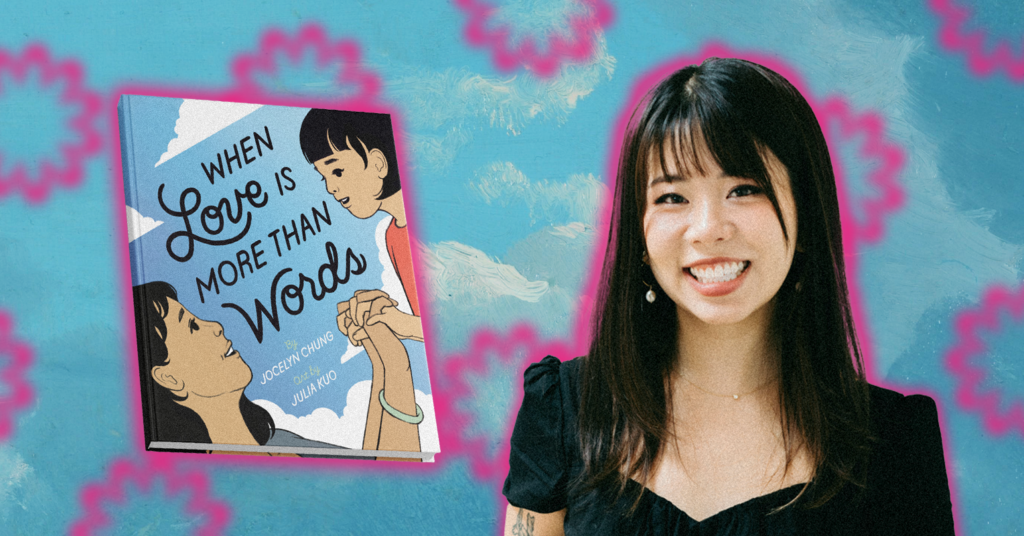Author Spotlight: Jocelyn Chung On Her Debut Picture Book And Expressing Love For Her Taiwanese Roots

Lí chiaah pá bōe? “Have you eaten yet?”
A common phrase of endearment in Taiwanese, food and looking out for the special people in your life is love in many families. Love is your mom cutting up fruit, like dragon fruit and mango, for you. Love is your A-gong — your grandpa — cheering you on with calls of “Ganbatte!” in Japanese. Love is these tastes, these words, these feelings.
This is the kind of love Taiwanese American author Jocelyn Chung explores in her debut picture book, When Love Is More Than Words. In this 14-page book of vibrant illustrations and lyrical text, Chung and fellow Taiwanese American artist Julia Kuo weave love, family, food, and cultural identity into its pages. Released today — October 15 — When Love Is More Than Words follows a young girl who discovers the many ways her family members express love.
Two months ahead of her book’s release date, EnVi Media spoke with Jocelyn Chung over Zoom about her author journey, the different ways to show “I love you,” and her favorite Taiwanese food.
With Love, From Taiwan and Beyond
For those who are familiar with Chung’s Instagram, you might already know that she has lived in Taiwan for about a year. Although Taiwan does make it into American news from time-to-time, the debut author wanted to share a different perspective of the island nation.
Right off the bat, Chung said, “Taiwan is warm.” (For anyone who has been to Taiwan, that is an uncontested statement.) “Temperature-wise in the summer,” she added with a little laugh. “But also the people. Taiwan is a very warm place — a warm, welcoming, friendly place.” She continued, “[Taiwanese people] will go out of their way to help you and that is just a part of Taiwanese culture.”
In addition, the pace of the island is slower, “extremely convenient,” and, of course, “the food is delicious everywhere,” Chung emphasized. From the diversity of cultures to the perseverance of the Taiwanese people, it’s “all layered together in this small and very green and lucious island,” she concluded.
But we couldn’t talk about Taiwan without talking about its food. As Chung noted, it’s too difficult to choose only one Taiwanese food because “there’s just too many!” However, she compromised and selected her top three, using their Taiwanese names: bah-oân, o-a-tsian, and lóo-bah-pn̄g.
“These are [the] most comforting flavors,” she said, explaining why the translucent dough filled with meat (bah wan), the savory, salty, and slightly slimy mixture of oyster omelets (o-a-tsian), and the braised pork over rice (lǔ ròu fàn) are her favorites. “All covering the three lovely textures of Taiwanese foods…Those are all things that I really love that are special to Taiwan and remind me of Taiwan,” Chung added.
The author also recommended the uánn-kué at Yongle Market in Tainan — a county in southern Taiwan and also where one of the first Taiwanese cities developed. Found in a traditional market, the “savory, steamed rice bowl cake” has pork and shrimp and “a drizzle of savory, sweetish sauce on top,” Chung described. “It’s super simple but surprisingly complex in [its] flavors.” She also admitted, “That uánn-kué, I have dreams of.”
While we chatted, the smooth sound of Taiwanese sometimes entered our conversation, including when Chung shared her favorite Taiwanese dishes. The language also appears in When Love Is More Than Words, like “Lí chiaah pá bōe?”
“[Taiwanese is] important to me because I grew up speaking Taiwanese not Mandarin,” Chung noted. “I only recently started learning Mandarin more when I lived in Taiwan, but growing up, my family mostly speaks Taiwanese.” When Chung’s mom emigrated to the U.S., her A-ma and A-gong (grandma and grandpa, respectively) went as well. Then Chung came along, and her family wanted to make sure, “Lì sī Tâi-uân lâng, it-tīng iàu kóng Tâi-gí.” You’re Taiwanese; you should speak Taiwanese! As a result, the Taiwanese words roll off her tongue with ease.
An Unexpected Author Journey
Besides being a published author, Chung is a graphic designer — a visual storyteller. Although some may think that much separates these two professions, for Chung, they are actually “very hand-in-hand.” She further emphasized, “It’s all connected because graphic design is visual storytelling.”
For example, Chung used to be an invitation designer for Evite. “Even then, you’re telling a story for someone’s birthday and how they want to invite someone to their child’s birthday party that’s firefighter-themed. There’s so many different ways to understand that there’s a story to be told with a design,” she said.
Writing is just another way of telling a story. And for Chung, “picture books always made the most sense” to her. Long before she became a picture book author herself, Chung started growing her picture book collection, which she showed EnVi on our call. “Children’s books have resonated with me,” Chung mused.
She, of course, has a list of picture books she has been loving lately: All The Ways To Be Smart written by Davina Bell and illustrated by Allison Colpoys; Eyes That Kiss in the Corners written by Joanna Ho and illustrated by Dung Ho; and Let’s Do Everything and Nothing written and illustrated by Julia Kuo. (On the latter story, Chung exclaimed, “I bought this book before she was even going to be illustrator!”)
Chung noted about her selections, “I just love books like this that help adults and kids understand there’s so many ways to expand the way that we view the world.” Her own book — When Love Is More Than Words — is one of those. Funnily enough, though, Chung’s goal wasn’t to be an author. “I think I kind of fell into writing a bit by accident,” she said. Clarifying a moment later, she added, “At least into publishing.”
However, Chung has always been a writer. She spoke of keeping journals and a secret blog in middle school, of “random writing docs” on her computer. But the major “turning point,” she called it, was when her maternal grandparents were diagnosed with cancer during the height of the COVID-19 pandemic.
“I started ferociously recording everything that I could,” Chung remembered. “[I was] reflecting constantly on the smell of [her A-ma and A-gong’s] house, the feeling of their hands in mine, the sound of the kitchen when my A-ma was cooking…Just recording all these things deep into my memory.”
She then began sharing these personal records on her Instagram — and people resonated deeply with them. A literary agent and an editor reached out separately to Chung, but she admitted to them that she didn’t have any manuscripts for them to look at. But, the story doesn’t end there. About a year later, Chung messaged them again. “I was like, ‘Hey, I actually have something now. I have a story to tell.’”
A Fullness of Love
Although When Love Is More Than Words is out now, it has been three years since Chung wrote and sold the original manuscript. “I was 25 when I wrote the story; I’m 28 now, so this has been a long journey,” she reflected.
In July of 2021, Chung was at the hospital with her A-gong. By this time, she was a full-time caretaker for both of her grandparents when they were sick. “I was in the hospital with him. He was watching tennis on my iPad and eating some blueberries and watermelon I had brought for him. I was just sitting on the side with my journal and just writing,” Chung said. “I was there for several hours, but I was just kind of recording the sounds and the smells…writing out the memory for myself so that I could absorb it fully.”
“This is a moment I want to remember,” she emphasized during our conversation.
Despite Chung and her A-gong sitting in silence for hours, they were together and full of love for each other. She thought about how “nothing [was] being said but [there was] an exuberance of love” in the room, even with the hospital smells and the beeping machines. That inspired Chung to write in her journal, starting with “I can tell that there is love through this, this, and this.” Then, she “started tracing back more and more.”
In the end, Chung wrote When Love Is More Than Words “within 12 hours.” After she left the hospital and went home, she “tied up the story.” This version was “nearly the same as what the final manuscript was,” Chung added.
Still, her debut picture book did undergo some changes. Since Chung was unfamiliar with the publishing process, her literary agent (Chris Park) and her editor at Penguin Random House (Nancy Paulsen), who are both “very well-experienced in this field,” helped Chung through the process. She learned that picture books only have 40 pages to tell a story. Actually, technically less than 40 because you need to factor in the dedication page and the ending pages as well. Besides this, “kids only have a finite length of attention,” Chung pointed out.
Thus, Park and Paulsen flagged words that might be too complex and abstract for a young child, like “sacred” and “resonance.” “What is sacred? What does that even mean?” Chung recalled. As a result, she exchanged these types of words for more concrete ones. A lot of the editing process, she noted, was to “make it more concrete, make it more simple.”
“I think it was a really challenging and beautiful exercise to take such large…concepts about what it’s like to have intergenerational caretaking, love, Taiwanese culture and identity and food, love and all these things,” Chung added. Even so, you can still “condense it into a way that a five year old could read.” And not only kids, but parents and grandparents, too, can also resonate with the story.
Chung had to find the “sweet spot[s]” of the words she chose for When Love Is More Than Words. They had to be “understandable yet resonating.” As Chung summed it up, “I was really specific with each word.”
When Love Is More Than Words
Speaking of words, however, why did Chung want to focus on love beyond the spoken “I love you?” To understand this story, the author took us back to the books she read when she was little. Chung grew up in an enthusiastic reading environment; “My mom read to us all the time, and we [were] always reading at home,” she said.
Picture books like Guess How Much I Love You and I Love You Forever stand out to her now as an adult. “All these words of love, it’s really nice to read as a child but also at the same time, I thought about as an adult, we rarely hear ‘I love you.’ And if we do, it’s almost uncomfortable,” Chung explained. “I started thinking, ‘What are ways that we express I love you that are not seen in children’s books?’”
She continued, “I thought that it’s a shame that in writing, it’s often limited to just saying ‘I love you.’ I felt like there’s a huge opportunity to be able to express this in a different way and showcase that love does not just need to come from ‘I love you.’”
By sharing other ways of expressing love, Chung believes kids will be able to better “observe and decipher” where that love is in their lives. “Because if you’re only reading books that are like ‘Well, I love you is just when your mom tells you I love you [or] your dad tells you I love you,’ then you start to think, ‘Oh, my parents then don’t love me if they tell me in a different way.’” she added. “You start to think, ‘Oh, something’s wrong with me’” because “my parents don’t do that,” Chung also noted.
“This is just one other way I wanted to be able to allow for all of us, no matter [our] background…there is love all around us — always,” she emphasized. Just like Chung shows in her text, we can “see it and observe and experience and taste and feel” love. It doesn’t only have to be saying “I love you” out loud.
Julia Kuo, who is Taiwanese American like Chung, shares the same message in her dynamic and boldly colorful illustrations. While Chung loves all of Kuo’s work in When Love Is More Than Words, she found one spread particularly impactful: when the child is sick and her mother is taking care of her. “I think being surrounded by food and fruit — things that nourish you — and also having your mom [at your] beside rubbing medicine and attending to your needs is one of the clearest easy of unspoken love and care from a parent.” Chung reflected.
“That spread is my favorite for a lot of reasons, because I think that is the most vivid of memories for myself of how I experienced love from my mom when I was sick,” Chung added. “But also because of the specificity that Julia went through.”
In this spread, the mother and child take center stage, but Kuo included a flurry of fruit and get-well-soon food around the pages, too. Chung mentioned that she noted a few fruits she wanted to have in this illustration; however, it was Kuo who took the details — and the love — one step further.
Take the mango in the upper left corner, for instance. “I didn’t even have to tell her like ‘Cut the mango this way,’” Chung expressed. “She really just did it on her own.” This page resonated with Chung so much because of the “level of understanding” Kuo showed through her art.
“That’s exactly how my mom cut mango for us,” Chung emphasized.
Before she sung Kuo’s praises, Chung noted that the artist was her “dream illustrator to work with on this book.” She continued, “Not only that, but [Kuo has] also been really like a big sister to me throughout this whole process.”
However, Chung and Kuo actually didn’t work directly with each other on When Love Is More than Words. An art director at their publisher was the middleman of sorts, so the “author and illustrator don’t really have direct communication” during the book-making journey. “I did give [Kuo] my manuscript [with] notes on each spread,” Chung pointed out, the notes being what she was thinking of having on each page. For the rest, meanwhile, Kuo “really took a free rein to image and bring the book to life in her own ways,” said Chung. “She went above and beyond to bring the book to life.”
This limited communication in the creative process doesn’t mean that Kuo and Chung are strangers. Rather, they have met in person twice — both times being in Taiwan. The duo will also meet again (online and in person) to do some joint book events these next few months.
What’s Next For Jocelyn Chung?
Following the release of When Love Is More Than Words, Jocelyn will be hosting a few storytimes and signings in California. However, in addition to doing events in the U.S., Chung is planning to come to Taiwan as well.
The newly-debuted author also has some more exciting book news: Chung is slated to publish another picture book in 2026 titled The River of Caregiving, with illustrations by Sarah Gonzales. In this upcoming work, Chung tackles the topic of intergenerational caretaking and “dive[s] even [deeper] into…how each generation takes care of the next.”
But for now, it’s When Love Is More Than Words’ time to shine. “I hope that readers will really enjoy this book, that they will share it with people that they love,” Chung said as our conversation started to wrap up. “Hopefully, [they] will have the experience…[of] feeling the depth of love that went into the book and the depth of love I hope that they realize is all around them as well.”
Keep up with Jocelyn Chung and her stories on Instagram and her website. When Love Is More Than Words can be found wherever you purchase your books.
Want to read more author interviews? Check out EnVi’s conversation with bestselling author Chloe Gong here!



